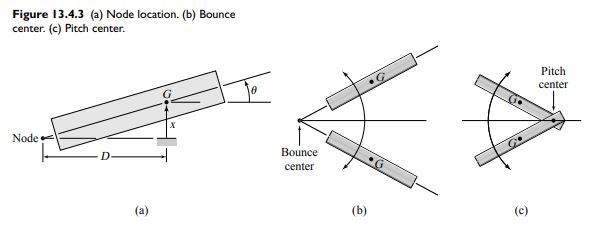Question 13.4.3: Pitch and Bounce Modes of a Vehicle Determine the mode shape...
Pitch and Bounce Modes of a Vehicle
Determine the mode shapes and mode frequencies of the vehicle shown in Figure 13.4.2.

Learn more on how we answer questions.
The mode ratio can be found from either (13.4.5) or (13.4.6). Choosing the former, we obtain
(ms^{2} + k_{1} + k_{2})A_{1} + (k_{2}L_{2} − k_{1}L_{1})A_{2} = 0 (13.4.5)
(k_{2}L_{2} − k_{1}L_{1})A_{1} + (I_{G} s^{2} + k_{1}L^{2}_{1} + k_{2}L^{2}_{2} ) A_{2} = 0 (13.4.6)
\frac{A_{1}}{A_{2}} = \frac{k_{1} L_{1} − k_{2} L_{2}}{ms^{2} + k_{1} + k_{2}} (1)
The mode ratio A_{1}/A_{2} can be thought of as the ratio of the amplitudes of x and θ in that mode.
From Figure 13.4.3a we find that
\tan θ = \frac{x}{D}
and for small angles θ,
D \approx \frac{x}{θ} = \frac{A_{1}}{A_{2}} (2)
The distance D locates a point called a “node” or “motion center” at which no motion occurs (that is, a passenger located at a node would not move if the vehicle were moving in the corresponding mode). Thus, there are two nodes, one for each mode.
Equation (1) shows that A_{1}, the amplitude of x, will be zero if
k_{1} L_{1} − k_{2} L_{2} = 0 (3)
In this case, equation (2) shows that D = 0. Thus, no coupling exists between the bounce motion x and the pitch motion θ, and the node for each mode is at the mass center. As we will discuss shortly, this condition will result in poor ride quality. Note also, that if equation (3) is satisfied,
the characteristic equation (13.4.7) can be factored as follows:
(ms^{2} + k_{1} + k_{2}) (I_{G} s^{2} + k_{1} L^{2}_{1} + k_{2}L^{2}_{2}) + (k_{2} L_{2} − k_{1}L^{1})^{2} = 0 (13.4.7)
(ms^{2} + k_{1} + k_{2}) (I_{G} s^{2} + k_{1} L^{2}_{1} + k_{2}L^{2}_{2} ) = 0
or
ms^{2} + k_{1} + k_{2} = 0 (4)
I_{G} s^{2} + k_{1} L^{2}_{1} + k_{2}L^{2}_{2} = 0 (5)
Each of these equations has a pair of imaginary roots. Thus both modes are oscillatory, and the modal frequencies are
ω_{1} = \sqrt{\frac{k_{1} + k_{2}}{m}}
ω_{2} = \sqrt{\frac{k_{1}L^{2}_{1} + k_{2}L^{2}_{2}}{I_{G}}}
